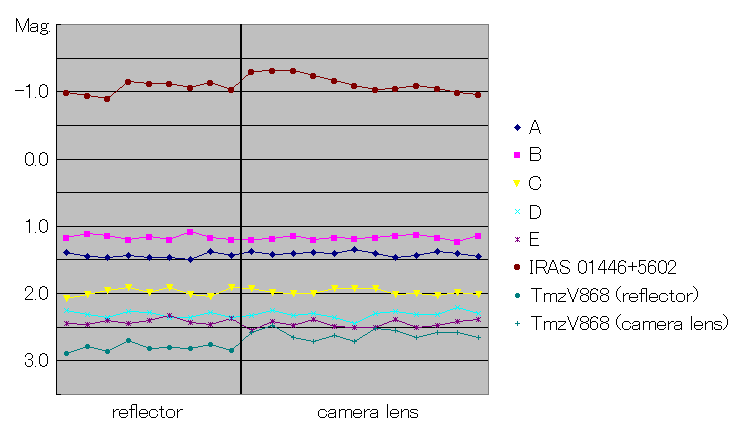Home Page Updated on February 27, 2003
Photometry of TmzV868February 27, 2003Yoshida, S.; Ohkura, N. TmzV868, R.A. 01h47m57s.596, Decl. +56o17'36".85 (J2000.0), is a new variable star discovered by Kesao Takamizawa [vsnet-newvar 1188]. It was originally reported as a possible Mira-type variable with a photographic range of 13.5 - <14.5 mag. Taichi Kato forwarded the notification by Nikolai N. Samus that the proposed identification of TmzV868 looks incompatible with the proposed classification and it may not be a Mira-type object as originally supposed [vsnet-newvar 1840]. In the course of MISAO Project, Nobuo Ohkura took 21 unfiltered CCD images of this field on 6 nights between 2000 August and 2001 November, using the 0.16-m f/3.8 Wright-Schmidt reflector and the 500-mm camera lens.
Date Instruments N. of images
-------------------------------------------
2000 Aug. 28 reflector 3 images
2000 Dec. 24 camera lens 4 images
2001 Sept.23 reflector 3 images
2001 Oct. 10 camera lens 4 images
2001 Nov. 15 reflector 3 images
2001 Nov. 24 camera lens 4 images
Here is the image of TmzV868. 
Here reports the photometry of TmzV868 and IRAS 01446+5602, using the five reference stars (A - E). The information of TmzV868, IRAS 01446+5602, and the five reference stars are as follows.
Seiichi Yoshida operated PSF photometry with a size of 7x7 pixels. The point spread function is created for each image using the five reference stars. Here is an image of the point spread function: 
and the stellar image of TmzV868: 
The table below shows the photometry of TmzV868, IRAS 01446+5602, and the five reference stars. The magnitude is a relative value to the brightness of the point spread function, the compounded brightness of the five reference stars.
IRAS
Star Star Star Star Star 01446 TmzV
JD A B C D E +5602 868
--------------------------------------------------------------
2451785.21826, 1.39, 1.16, 2.08, 2.25, 2.45, -0.99, 2.89
2451785.22012, 1.45, 1.11, 2.02, 2.31, 2.46, -0.95, 2.79
2451785.22197, 1.47, 1.13, 1.95, 2.36, 2.40, -0.90, 2.86
2451902.93351, 1.37, 1.19, 1.92, 2.33, 2.55, -1.30, 2.58
2451902.93536, 1.42, 1.18, 1.99, 2.25, 2.42, -1.32, 2.47
2451902.93722, 1.41, 1.14, 2.00, 2.32, 2.47, -1.32, 2.65
2451902.93907, 1.39, 1.20, 2.00, 2.30, 2.39, -1.24, 2.71
2452176.15456, 1.43, 1.20, 1.91, 2.27, 2.44, -1.15, 2.70
2452176.15642, 1.46, 1.15, 1.99, 2.28, 2.40, -1.13, 2.81
2452176.15828, 1.46, 1.19, 1.91, 2.36, 2.32, -1.12, 2.80
2452193.14162, 1.40, 1.17, 1.93, 2.35, 2.49, -1.17, 2.63
2452193.14359, 1.35, 1.18, 1.93, 2.45, 2.50, -1.10, 2.71
2452193.14556, 1.41, 1.17, 1.93, 2.30, 2.51, -1.03, 2.52
2452193.14752, 1.47, 1.14, 2.02, 2.26, 2.39, -1.05, 2.55
2452229.06743, 1.50, 1.08, 2.01, 2.35, 2.43, -1.07, 2.81
2452229.06940, 1.38, 1.17, 2.05, 2.28, 2.46, -1.14, 2.75
2452229.07138, 1.44, 1.19, 1.91, 2.36, 2.37, -1.03, 2.84
2452238.01793, 1.43, 1.12, 2.00, 2.31, 2.51, -1.10, 2.66
2452238.01990, 1.38, 1.16, 2.03, 2.31, 2.47, -1.05, 2.58
2452238.02188, 1.41, 1.22, 1.99, 2.20, 2.42, -0.99, 2.58
2452238.02384, 1.45, 1.14, 2.02, 2.30, 2.39, -0.96, 2.66
Here is the light curve. 
The brightness of the five reference stars look constant. The light curve of IRAS 01446+5602 looks variable. The variability of this object is also suggested by the IRAS record as 45%. So it may be a new red variable star, with a range of at least 0.3 mag. But TmzV868 was remarked as "TmzV868 is located between GSC3692.2365 star (N) and GSC3692.946 star (SW)" in the orginal announcement [vsnet-newvar 1188]. So it does not mean the mis-identification of TmzV868. The brightness of TmzV868 shows a possible systematic difference between the reflector and the camera lens. The graph below shows the measured magnitude for each image. 
TmzV868 seems faint on all reflector images, and bright on all camera lens images. The magnitude of TmzV868 on each night is as follows:
Instruments Date Magnitude
---------------------------------------------
reflector 2000 Aug. 28 2.85 +/- 0.042
2001 Sept.23 2.76 +/- 0.050
2001 Nov. 15 2.80 +/- 0.037
---------------------------------------------
camera lens 2000 Dec. 24 2.60 +/- 0.089
2001 Oct. 10 2.60 +/- 0.074
2001 Nov. 24 2.62 +/- 0.040
---------------------------------------------
which suggests the systematic difference of 0.20 mag. A systematic difference of magnitude between the reflector and camera lens is sometimes found in the case of a very red star. But the USNO-A2.0 color of TmzV868 is not red, B-R = 0.9 mag. So the reason is still uncertain. Anyway, the brightness of TmzV868 is almost constant among the reflector images, or among the camera lens images. It supports that TmzV868 is not a Mira-type object as originally supposed. Conclusion: No evident variation of TmzV868 was detected, which supports that TmzV868 is not a Mira-type object as originally supposed. Nearby IRAS 01446+5602 may be a red variable, but it does not mean the mis-identification of TmzV868. TmzV868 shows a possible systematic difference of magnitude between the reflector and camera lens, but the reason is uncertain.
References |
